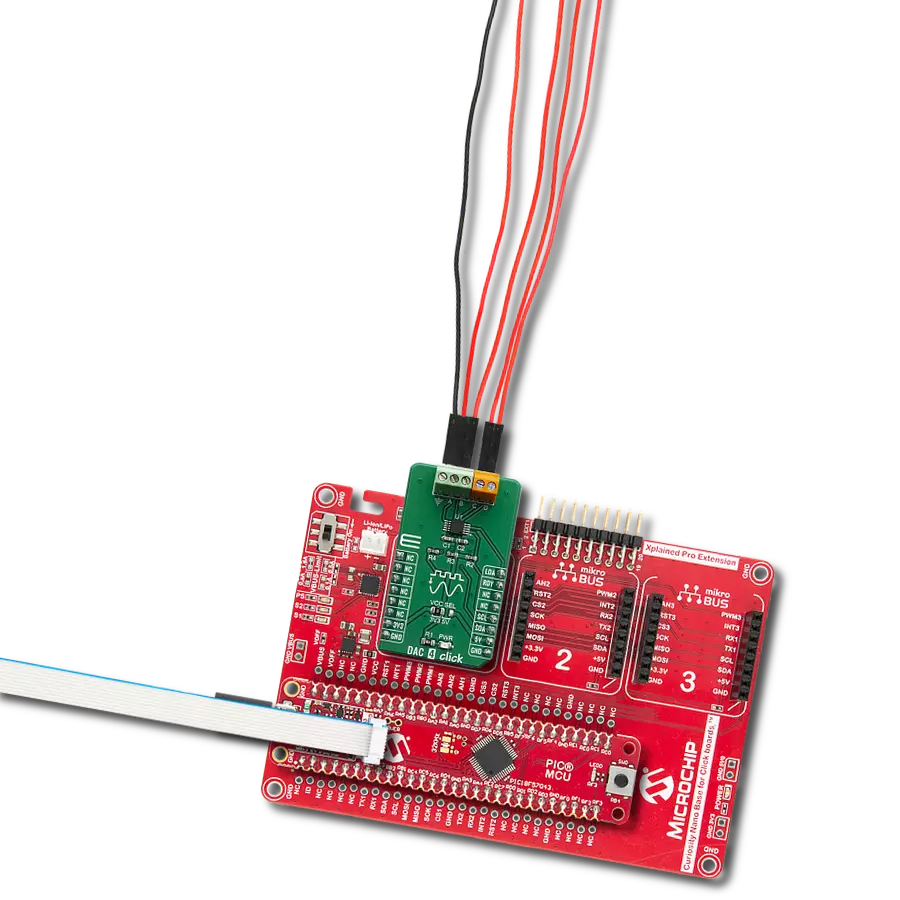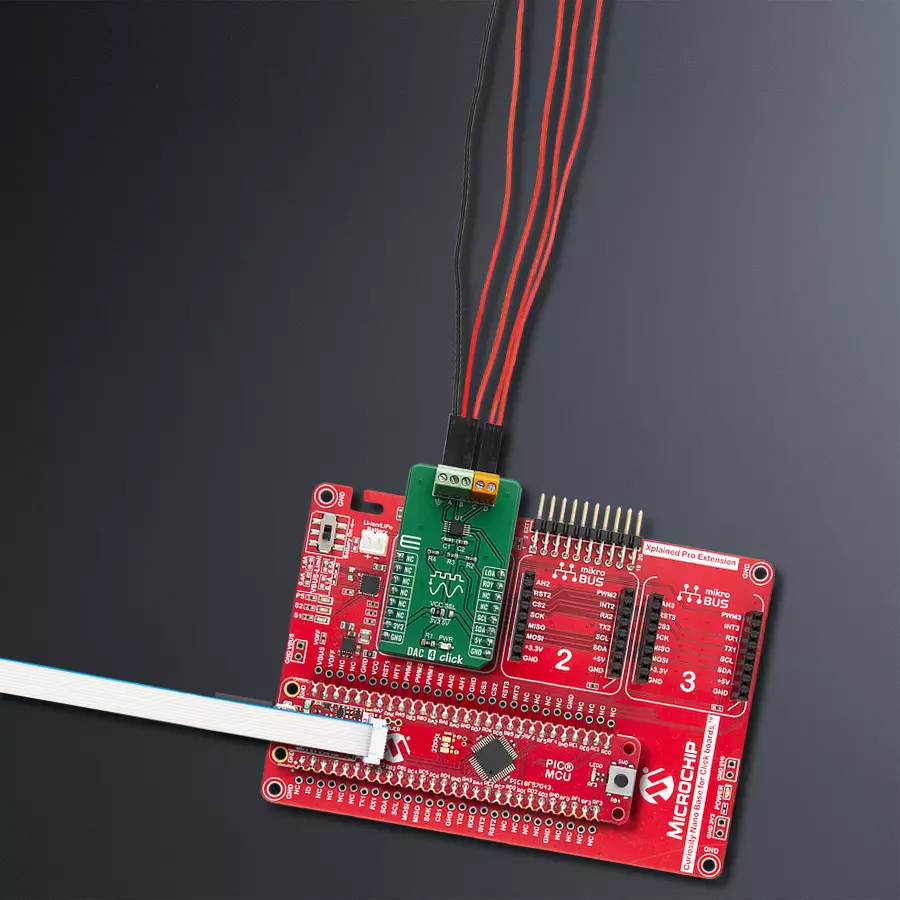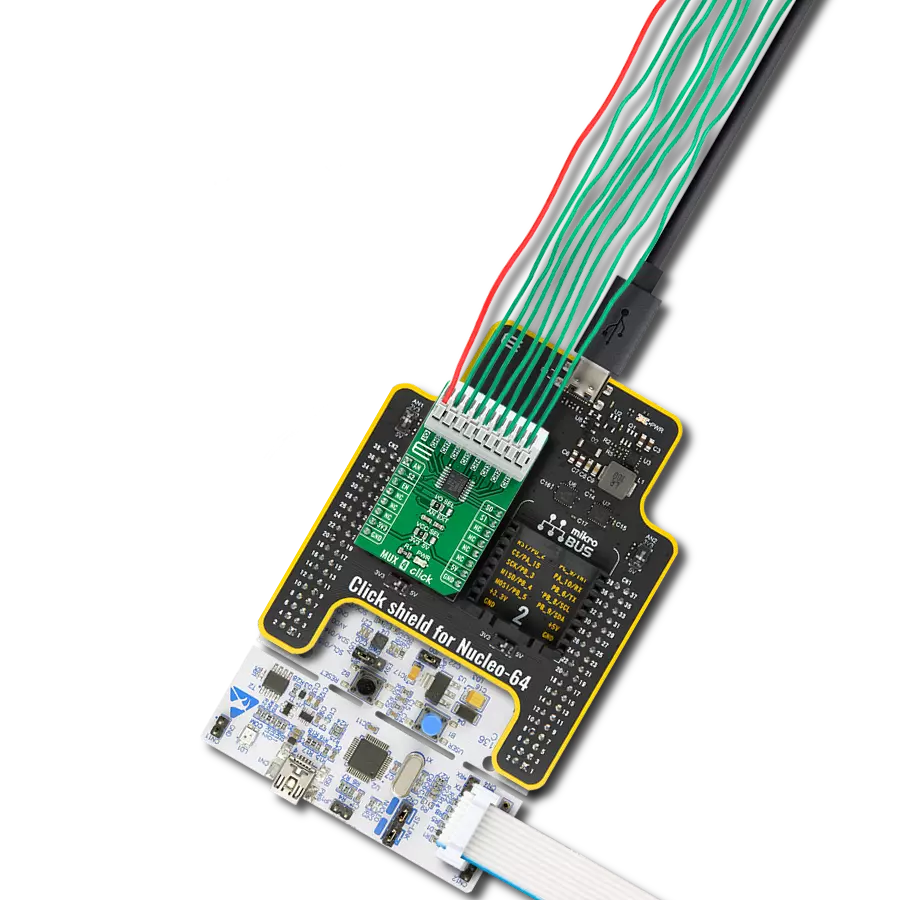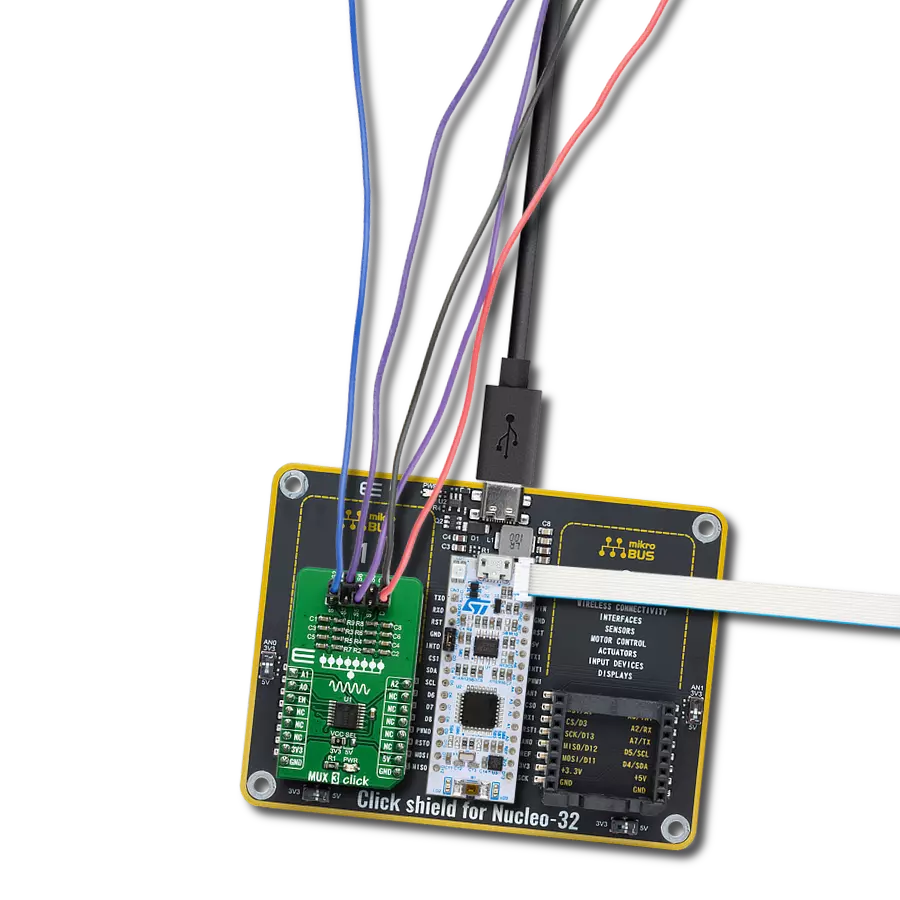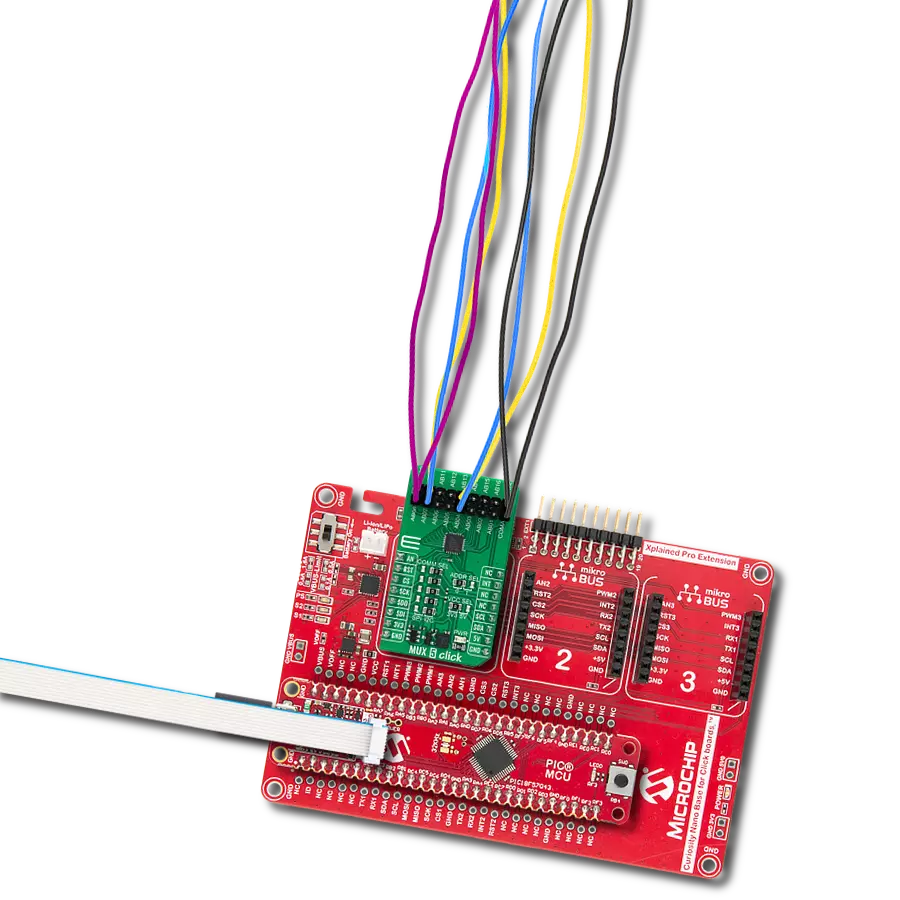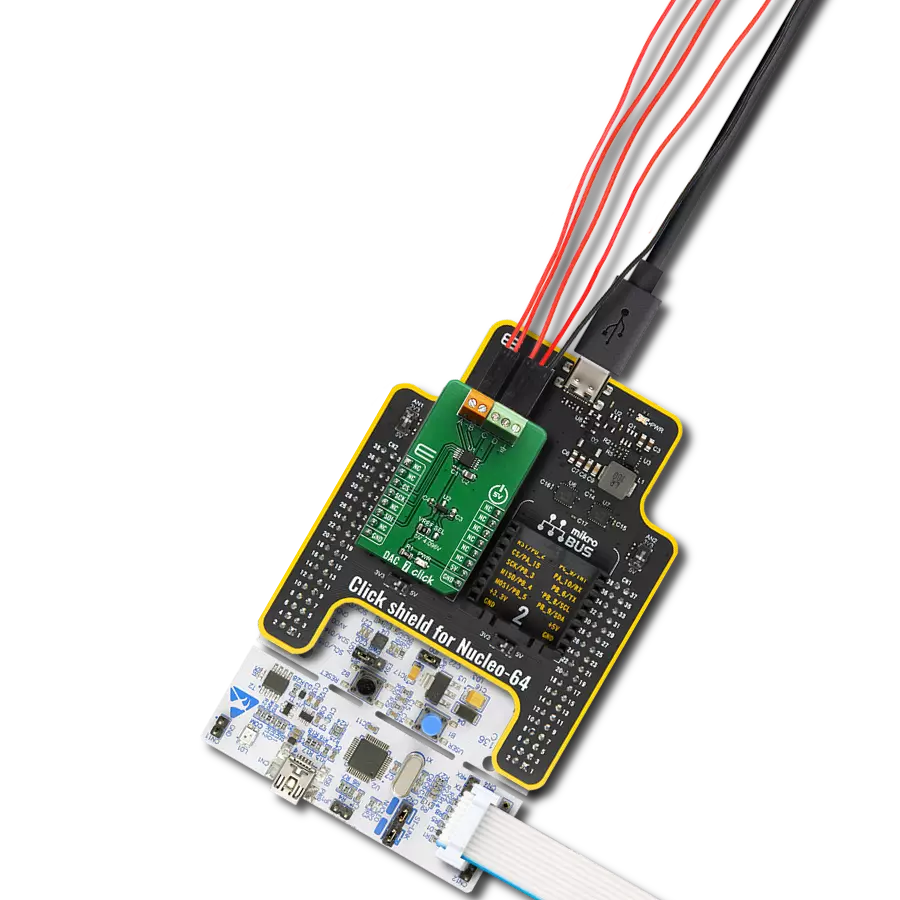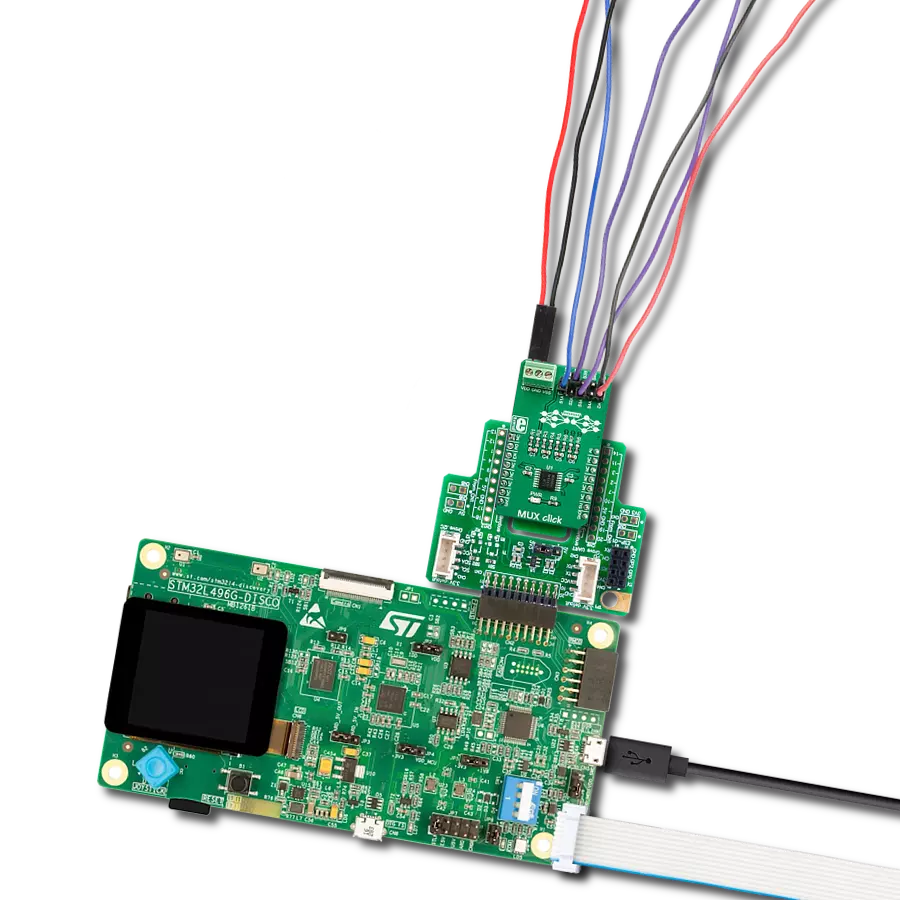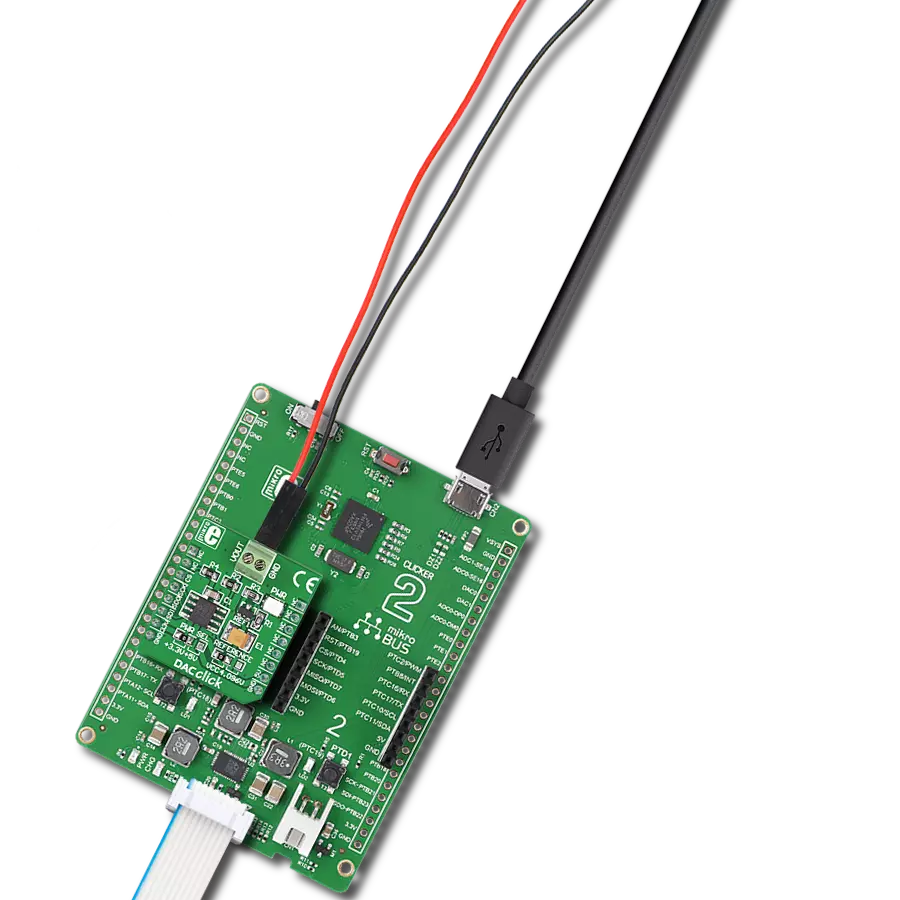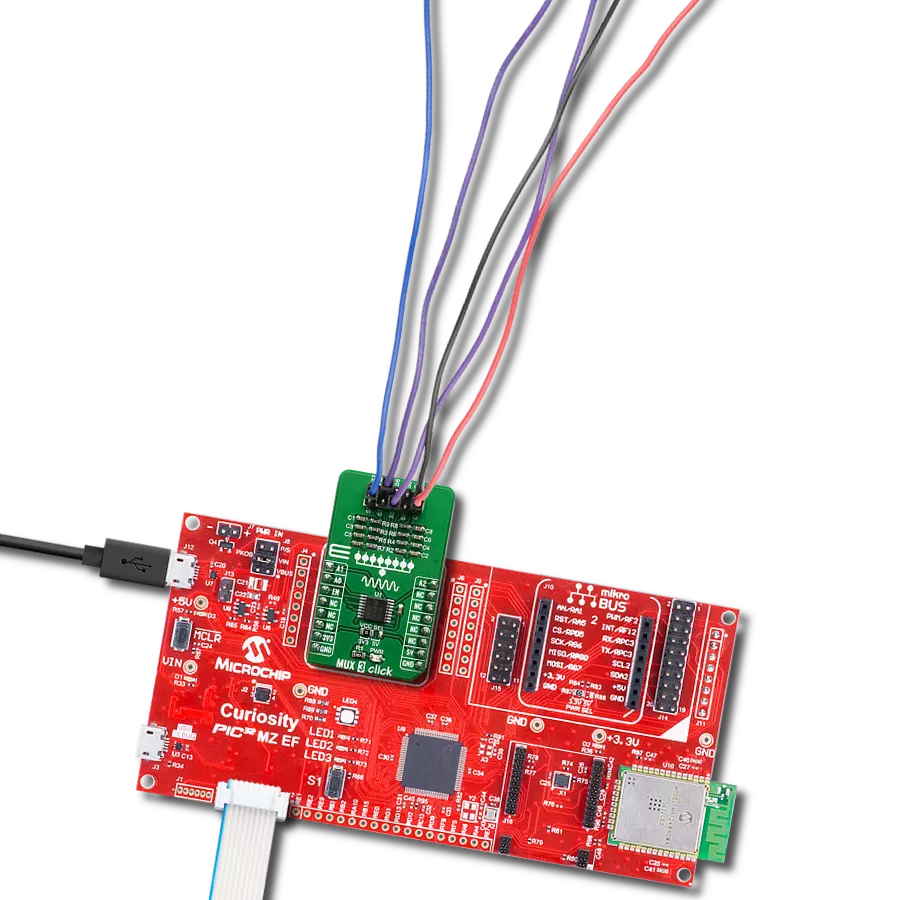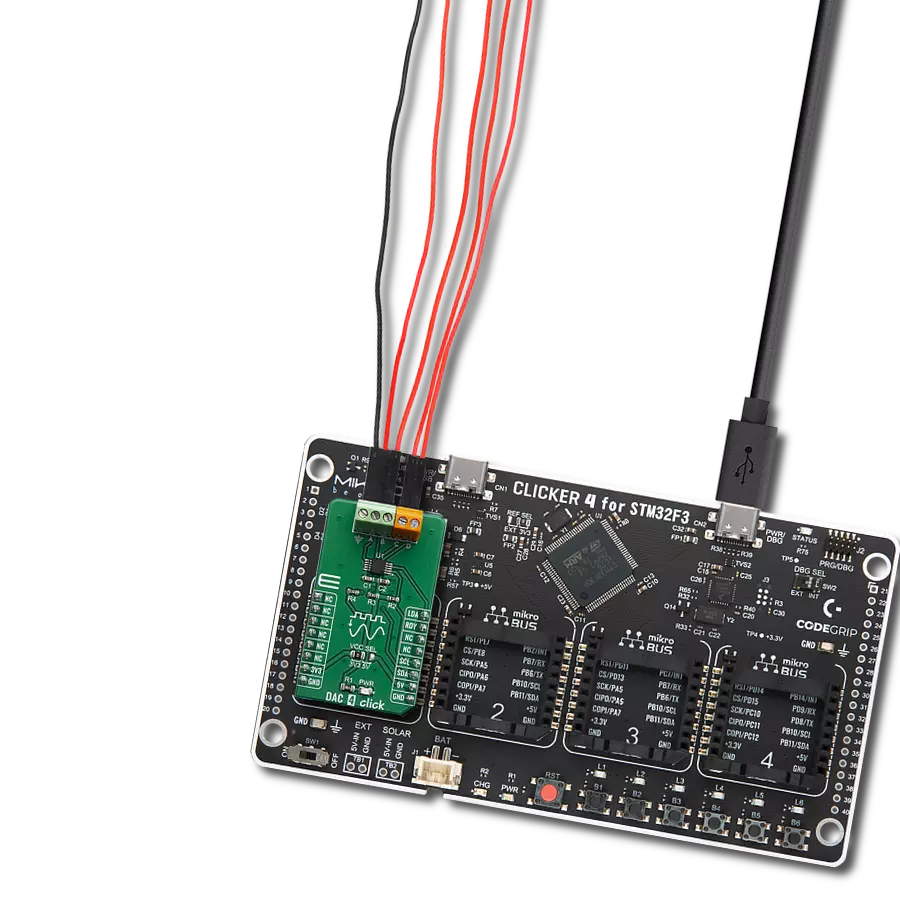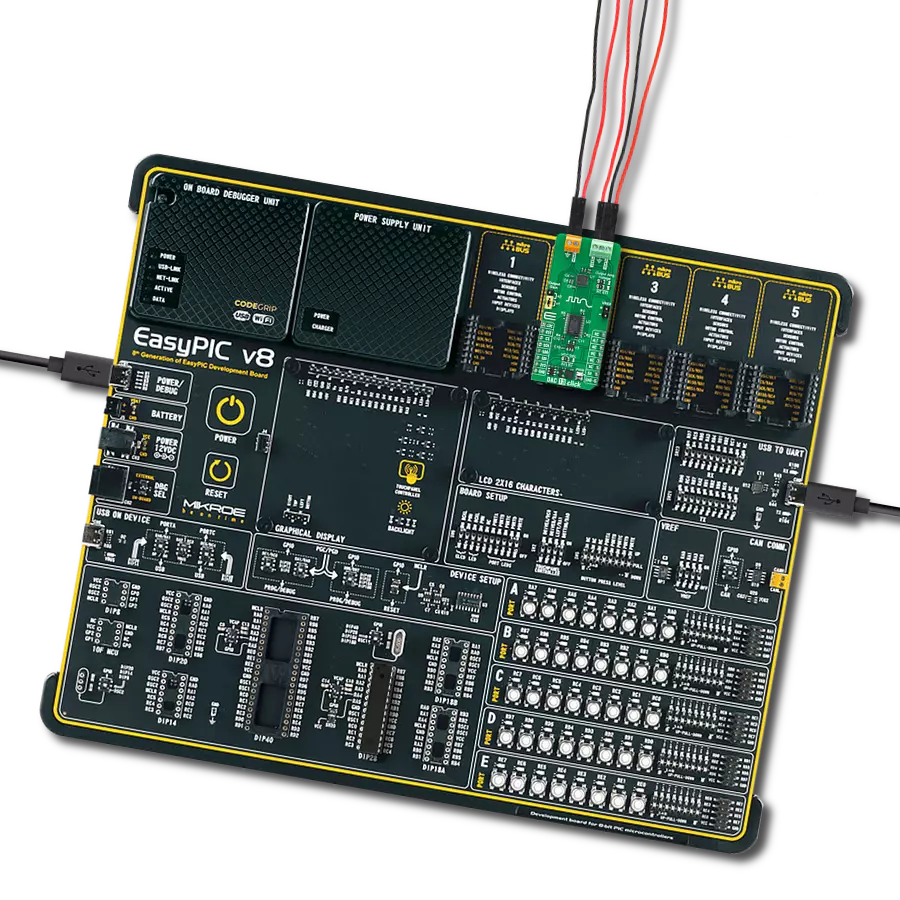Designed for precision, it transforms digital insights into analog realities, enabling seamless communication and decision-making
A
A
Hardware Overview
How does it work?
DAC 4 Click is based on the MCP4728, a quad, 12-bit voltage output Digital-to-Analog converter (DAC) with nonvolatile memory (EEPROM) from Microchip. Its onboard precision output amplifier allows it to achieve rail-to-rail analog output swing. The DAC input codes, device configuration bits, and I2C address bits are programmable to the nonvolatile memory (EEPROM) using I2C serial interface commands. The nonvolatile memory feature enables the DAC device to hold the DAC input codes during power-off time, allowing the DAC outputs to be available immediately after power-up with the saved settings. The MCP4728 device has a high-precision internal voltage reference (VREF = 2.048V). The user can select the internal reference, or an external reference may be used (VDD) for each channel individually. This
gives the ADC 4-click good flexibility for use in various applications. Each channel can be operated individually in Normal mode or Power-Down mode by setting the configuration register bits. In Power-Down mode, most of the internal circuits in the powered-down channel are turned off for power savings, and the output amplifier can be configured to present a known low, medium, or high resistance output load. This device also includes a Power-on Reset (POR) circuit to ensure reliable power-up and an onboard charge pump for the EEPROM programming voltage. The MCP4728 has four output pins routed to the output terminal blocks (TB1 and TB2). The output range of the DAC is 0 V to VREF or 0 V to 2×V REF. The communication with the main MCU is established over a two-wire I2C compatible serial
interface, with standard (100 kHz), fast (400 kHz), or high speed (3.4 MHz) modes supported. The I2C lines (SCL and SDA) are routed to the dedicated mikroBUS™pins. The LDA pin is a multipurpose GPIO: It can be used as Synchronization input or for the device I2C address selection. RDY pin can also optionally be used to monitor the status of EEPROM programming activity. This Click board™ can operate with either 3.3V or 5V logic voltage levels selected via the VCC SEL jumper. This way, both 3.3V and 5V capable MCUs can use the communication lines properly. Also, this Click board™ comes equipped with a library containing easy-to-use functions and an example code that can be used, as a reference, for further development.
Features overview
Development board
PIC18F57Q43 Curiosity Nano evaluation kit is a cutting-edge hardware platform designed to evaluate microcontrollers within the PIC18-Q43 family. Central to its design is the inclusion of the powerful PIC18F57Q43 microcontroller (MCU), offering advanced functionalities and robust performance. Key features of this evaluation kit include a yellow user LED and a responsive
mechanical user switch, providing seamless interaction and testing. The provision for a 32.768kHz crystal footprint ensures precision timing capabilities. With an onboard debugger boasting a green power and status LED, programming and debugging become intuitive and efficient. Further enhancing its utility is the Virtual serial port (CDC) and a debug GPIO channel (DGI
GPIO), offering extensive connectivity options. Powered via USB, this kit boasts an adjustable target voltage feature facilitated by the MIC5353 LDO regulator, ensuring stable operation with an output voltage ranging from 1.8V to 5.1V, with a maximum output current of 500mA, subject to ambient temperature and voltage constraints.
Microcontroller Overview
MCU Card / MCU

Architecture
PIC
MCU Memory (KB)
128
Silicon Vendor
Microchip
Pin count
48
RAM (Bytes)
8196
You complete me!
Accessories
Curiosity Nano Base for Click boards is a versatile hardware extension platform created to streamline the integration between Curiosity Nano kits and extension boards, tailored explicitly for the mikroBUS™-standardized Click boards and Xplained Pro extension boards. This innovative base board (shield) offers seamless connectivity and expansion possibilities, simplifying experimentation and development. Key features include USB power compatibility from the Curiosity Nano kit, alongside an alternative external power input option for enhanced flexibility. The onboard Li-Ion/LiPo charger and management circuit ensure smooth operation for battery-powered applications, simplifying usage and management. Moreover, the base incorporates a fixed 3.3V PSU dedicated to target and mikroBUS™ power rails, alongside a fixed 5.0V boost converter catering to 5V power rails of mikroBUS™ sockets, providing stable power delivery for various connected devices.
Used MCU Pins
mikroBUS™ mapper
Take a closer look
Click board™ Schematic

Step by step
Project assembly
Software Support
Library Description
This library contains API for DAC 4 Click driver.
Key functions:
dac4_voltage_reference_set- Setting channel voltage reference valuesdac4_gain_set- Writing channel gain valuesdac4_data_report- Reading channel data and forming reports
Open Source
Code example
The complete application code and a ready-to-use project are available through the NECTO Studio Package Manager for direct installation in the NECTO Studio. The application code can also be found on the MIKROE GitHub account.
/*!
* \file
* \brief Dac4 Click example
*
* # Description
* This application enables usage of digital to analog converter.
*
* The demo application is composed of two sections :
*
* ## Application Init
* Initializes I2C driver, executes general call reset and wake up commands.
*
* ## Application Task
* Changes the output voltage of channels every 3 seconds, and displays
* the channels status on the USB UART.
*
* \author MikroE Team
*
*/
// ------------------------------------------------------------------- INCLUDES
#include "board.h"
#include "log.h"
#include "dac4.h"
// ------------------------------------------------------------------ VARIABLES
static dac4_t dac4;
static log_t logger;
// ------------------------------------------------------- ADDITIONAL FUNCTIONS
void dac4_log_report ( uint8_t channel_no )
{
dac4_channel_setting_t dac4_channel_buffer[ 8 ];
dac4_data_report ( &dac4, dac4_channel_buffer );
channel_no *= 2;
log_printf( &logger, "--- Power ON bit: " );
switch ( dac4_channel_buffer[ channel_no ].por_bit )
{
case 0:
{
log_printf( &logger,"Power OFF\r\n" );
break;
}
case 1:
{
log_printf( &logger, "Power ON\r\n" );
break;
}
default :
{
break;
}
}
log_printf( &logger, "--- V reference : " );
switch ( dac4_channel_buffer[ channel_no ].voltage_reference )
{
case DAC4_VREF_EXTERNAL:
{
log_printf( &logger, "External\r\n" );
break;
}
case DAC4_VREF_INTERNAL:
{
log_printf( &logger, "Internal\r\n" );
break;
}
default :
{
break;
}
}
log_printf( &logger, "--- Power mode : " );
switch ( dac4_channel_buffer[ channel_no ].power_mode )
{
case DAC4_MODE_NORMAL:
{
log_printf( &logger, "Normal\r\n" );
break;
}
case DAC4_MODE_1kOhm:
{
log_printf( &logger, "1 kOhm\r\n" );
break;
}
case DAC4_MODE_100kOhm:
{
log_printf( &logger, "100 kOhm\r\n" );
break;
}
case DAC4_MODE_500kOhm:
{
log_printf( &logger, "500 kOhm\r\n" );
break;
}
default :
{
break;
}
}
log_printf( &logger, "--- Gain value : " );
switch ( dac4_channel_buffer[ channel_no ].gain_value )
{
case DAC4_MODE_NORMAL:
{
log_printf( &logger, "1x Gain\r\n" );
break;
}
case DAC4_MODE_1kOhm:
{
log_printf( &logger, "2x Gain\r\n" );
break;
}
default :
{
break;
}
}
log_printf( &logger, "--- DAC input data : %d [0-4095]\r\n", dac4_channel_buffer[ channel_no ].dac_input_data );
log_printf( &logger, "-------------------------------------\r\n" );
}
void dac4_set_output ( uint8_t channel_set )
{
dac4_channel_setting_t dac4_channel_x;
static uint16_t aux_dac_input_data = 0;
dac4_channel_x.channel_select = channel_set;
dac4_channel_x.udac_bit = DAC4_UPDATE;
dac4_channel_x.voltage_reference = DAC4_VREF_EXTERNAL;
dac4_channel_x.power_mode = DAC4_MODE_NORMAL;
dac4_channel_x.gain_value = DAC4_GAIN_x1;
dac4_channel_x.dac_input_data = aux_dac_input_data;
if ( 0 != dac4_single_write( &dac4, &dac4_channel_x ) )
{
log_printf( &logger, "--- Fatal ERROR !!! \r\n" );
}
else
{
log_printf( &logger, "------------------------------------- \r\n" );
log_printf( &logger, "--- Output setup done \r\n" );
log_printf( &logger, "------------------------------------- \r\n" );
aux_dac_input_data += 500;
if ( aux_dac_input_data > 4095 )
{
aux_dac_input_data = 0;
}
}
}
void dac4_channel_report ( )
{
log_printf( &logger, "\r\n -----> Channel A \r\n" );
dac4_set_output( DAC4_CHANNEL_A );
dac4_log_report( 0 );
Delay_ms ( 1000 );
Delay_ms ( 1000 );
Delay_ms ( 1000 );
log_printf( &logger, "\r\n -----> Channel B \r\n" );
dac4_set_output( DAC4_CHANNEL_B );
dac4_log_report( 1 );
Delay_ms ( 1000 );
Delay_ms ( 1000 );
Delay_ms ( 1000 );
log_printf( &logger, "\r\n -----> Channel C \r\n" );
dac4_set_output( DAC4_CHANNEL_C );
dac4_log_report( 2 );
Delay_ms ( 1000 );
Delay_ms ( 1000 );
Delay_ms ( 1000 );
log_printf( &logger, "\r\n -----> Channel D \r\n" );
dac4_set_output( DAC4_CHANNEL_D );
dac4_log_report( 3 );
Delay_ms ( 1000 );
Delay_ms ( 1000 );
Delay_ms ( 1000 );
}
// ------------------------------------------------------ APPLICATION FUNCTIONS
void application_init ( void )
{
log_cfg_t log_cfg;
dac4_cfg_t cfg;
/**
* Logger initialization.
* Default baud rate: 115200
* Default log level: LOG_LEVEL_DEBUG
* @note If USB_UART_RX and USB_UART_TX
* are defined as HAL_PIN_NC, you will
* need to define them manually for log to work.
* See @b LOG_MAP_USB_UART macro definition for detailed explanation.
*/
LOG_MAP_USB_UART( log_cfg );
log_init( &logger, &log_cfg );
log_info( &logger, "---- Application Init ----" );
// Click initialization.
dac4_cfg_setup( &cfg );
DAC4_MAP_MIKROBUS( cfg, MIKROBUS_1 );
dac4_init( &dac4, &cfg );
log_info( &logger, "---- Application ----" );
Delay_ms ( 500 );
dac4_general_call_reset( &dac4 );
Delay_ms ( 500 );
dac4_general_call_wake_up( &dac4 );
Delay_ms ( 500 );
log_printf( &logger, "--- App init done \r\n \r\n" );
}
void application_task ( void )
{
dac4_channel_report( );
}
int main ( void )
{
/* Do not remove this line or clock might not be set correctly. */
#ifdef PREINIT_SUPPORTED
preinit();
#endif
application_init( );
for ( ; ; )
{
application_task( );
}
return 0;
}
// ------------------------------------------------------------------------ END
Additional Support
Resources
Category:DAC
